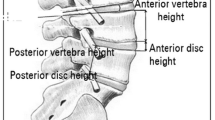Abstract
Introduction
The effect of transforaminal lumbar interbody fusion (TLIF) with one cage and excised local bone were investigated in 52 patients with a mean follow-up of 18.2 months.
Method
The clinical outcomes including the modified Prolo scale and a visual analog scale (VAS), and radiological assessments including the ratio of interbody graft area, fusion rate, posterior disk height (PH), and the lordosis angle (LA) of the motion segment were studied.
Results
According to a modified Prolo scale, 90.4% of the patients obtained either excellent or good results. The VAS significantly decreased postoperatively. There was significant postoperative improvement of the PH and LA, and no significant loss of the PH and LA was found at final follow-up. The fusion rate in this series was 96.6%.
Conclusion
In conclusion, TLIF with one cage and excised local bone grafting can provide satisfactory treatment outcomes and solid interbody fusion without harvesting and grafting autologous iliac bone.




Similar content being viewed by others
References
Blume HG, Rojas CH (1981) Unilateral lumbar interbody fusion (posterior approach) utilizing dowel graft. J Neurol Orthop Surg 2:171–175
Harms J, Rolinger H (1982) Die operative Behandlung der Spondylolisthese durch dorsale Aufrichtung und ventrale Verblockung. Z Orthop Ihre Grenzgeb 120:342–347
Harms J, Jeszensky D, Stolze D (1997) True spondylolisthesis reduction and more segmental fusion. In: Bridwell KH, DeWald RL et al (eds) The textbook of spinal surgery, 2nd edn. Lippincott-Raven, Philadelphia, pp 1337–1347
Harms J, Jeszensky D (1998) The unilateral transforaminal approach for posterior lumbar interbody fusion. Orthop Traumatol 6:88–99
Humphreys SC, Hodges SD, Patwardhan AG et al (2001) Comparison of posterior and transforaminal approaches to lumbar interbody fusion. Spine 26:567–571
Turner PL (1994) Neurologic complications of posterior lumbar interbody fusion. Presented at the annual meeting of the Spine Society of Australia, Melbourne, Australia, 14 May 1994
Ray CD (1997) Threaded titanium cages for lumbar interbody fusion. Spine 22:667–680
Fritzell P, Hagg O, Wessberg P et al (2002) Chronic low back pain and fusion: a comparison of three surgical techniques. Spine 27:1131–1141
Madan S, Boeree NR (2002) Outcome of posterior lumbar interbody fusion versus posterolateral fusion for spondylolytic spondylolisthesis. Spine 27:1536–1542
Harris BM, Hilibrand AS, Savas PE et al (2004) Transforaminal lumbar interbody fusion: the effect of various instrumentation techniques on the flexibility of the lumbar spine. Spine 29:E65–E70
Brantigan JW, Steffee AD, Lewis ML et al (2000) Lumbar interbody fusion using the Brantigan I/F cage for posterior lumbar interbody fusion and the variable pedicle screw placement system: two-year results from a Food and Drug Administration investigational device exemption clinical trial. Spine 25:1437–1446
McAfee PC, Devine JG, Chaput CD et al (2005) The indications for interbody fusion cages in the treatment of spondylolisthesis: analysis of 120 cases. Spine 30:S60–S65
Hackenberg L, Halm H, Bullmann V et al (2005) Transforaminal lumbar interbody fusion: a safe technique with satisfactory three to five year results. Eur Spine J 14:551–558
Younger EM, Chapman MW (1989) Morbidity at bone graft donor sites. J Orthop Trauma 3:192–195
Abe E, Sato K, Shimada Y et al (1995) Posterior lumbar interbody fusion using bioactive ceramic intevertebral spacers and pedicle screw fixation for degenerative spondylolisthesis. Rinsho Seikei Geka 30:919–927
Bodian CA, Freedman G, Hossain S et al (2001) The visual analog scale for pain: clinical significance in postoperative patients. Anesthesiology 95:1356–1361
Okuyama K, Kido T, Unoki E et al (2007) PLIF with a titanium cage and excised facet joint bone for degenerative spondylolisthesis-in augmentation with a pedicle screw. J Spinal Disord Tech 20:53–59
Bambakidis NC, Feiz-Erfan I, Klopfenstein JD et al (2005) Indications for surgical fusion of the cervical and lumbar motion segment. Spine 30:S2–S6
Zhao J, Wang X, Hou T et al (2002) One versus two BAK fusion cages in posterior lumbar interbody fusion to L4–L5 degenerative spondylolisthesis: a randomized, controlled prospective study in 25 patients with minimum two-year follow-up. Spine 27:2753–2757
Hee HT, Majd ME, Holt RT et al (2003) Do autologous growth factors enhance transforaminal lumbar interbody fusion? Eur Spine J 12:400–407
Ames CP, Acosta FL Jr, Chi J et al (2005) Biomechanical comparison of posterior lumbar interbody fusion and transforaminal lumbar interbody fusion performed at 1 and 2 levels. Spine 30:E562–E566
Javernick MA, Kuklo TR, Polly DW Jr (2003) Transforaminal lumbar interbody fusion: unilateral versus bilateral disk removal—an in vivo study. Am J Orthop 32:344–348
Coe JD (2004) Instrumented transforaminal lumbar interbody fusion with bioabsorbable polymer implants and iliac crest autograft. Neurosurg Focus 16(3):E11
Fernyhough JC, Schimandle JJ, Weigel MC et al (1992) Chronic donor site pain complicating bone graft harvesting from the posterior iliac crest for spinal fusion. Spine 17:1474–1480
Acknowledgments
This article is supported by the scientific research fund of Health Bureau of Zhejiang Province, and the fund number is 2008A096.
Author information
Authors and Affiliations
Corresponding author
Rights and permissions
About this article
Cite this article
Xiao, Y., Li, F. & Chen, Q. Transforaminal lumbar interbody fusion with one cage and excised local bone. Arch Orthop Trauma Surg 130, 591–597 (2010). https://doi.org/10.1007/s00402-009-0917-6
Received:
Published:
Issue Date:
DOI: https://doi.org/10.1007/s00402-009-0917-6




